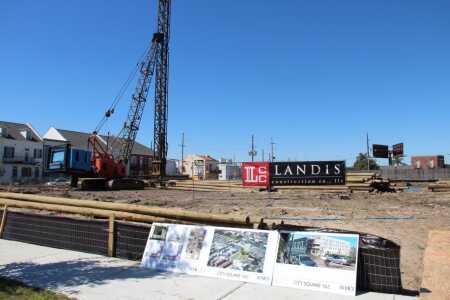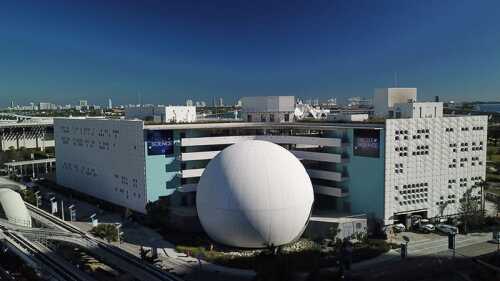As in many growing U.S. cities, much of the new housing in New Orleans is on the high end. According to HousingNOLA, an advocacy group, thecity needs to build more than 33,000 additional units of affordable housing by 2025 to meet the demand created by a city that is still recovering from the aftereffects of HurricaneKatrina, while feeling the effects of a growing population, and is driven by a relatively low-wage service economy.
In late February, the city, the Housing Authority of New Orleans (HANO), and community developer McCormack Baron Salazar broke ground on a new mixed-income housing project in the Tremé neighborhood that will help meet some of that need. Known as City Square 162, the four-story apartment building will have 76 one- and two-bedroom units. Of those, 15 units will be subsidized public housing and 15 will be reserved for Section 8 voucher holders. The remaining 46 units will be rented at market rates. McCormack Baron Salazar said that all of the units are built to the same standard, regardless of whether they have subsidized rents.
The development includes a community event space, a computer lab, and a fitness center. Residents will have access to wraparound support such as referral services, recreation, wellness and life skills programs, parenting support, and after-school and summer programs. The project lies just a block away from the historic Congo Square and sits adjacent to the Laffite Greenway. The developer is going to build a bicycle and pedestrian path to connect the property to the popular Greenway. The project is slated to be completed by June 2021 and McCormack Baron Salazar will serve as property manager.
“We don’t believe that just building big buildings will make a difference in the lives of people and change neighborhoods,” says JudithMoran, McCormack Baron Salazar’s vice president of project management. “You’ve got to bring in the services people need, the educational facilities, the support to the families, the green space. All of those things have to come into the mix to make neighborhoods of choice, communities of choice, homes of choice where people really choose to live there.”
The 30 affordable units at City Square 162 are a small part of a broader, years-long effort by HANO to replace the housing lost when the nearby Iberville public housing development was demolished in 2013. The 821-unit complex was the last of New Orleans’s original public housing developments. The $23 million City Square project was funded in part by a ChoiceNeighborhoods Initiative grant that HANO received from the U.S. Department of Housing and Urban Development (HUD). The rest of the funding came from a mix of low-income housing tax credits, grants, and loans.
HUD’s Choice NeighborhoodsInitiative program funds the replacement and redevelopment of public housingprojects. It comes with mandates that the city replace every unit lost from thepublic housing, that projects be mixed-income and help spur economicdevelopment in the neighborhood, and that former public housing residents getthe first opportunity to return to the new housing. In the case of City Square,former Iberville residents will get first priority to move into the buildingregardless of whether they are still low-income. If they no longer qualify forsubsidized units, they get first priority for the market-rate units.
The largest collection of replacement units was built on theIberville site. BienvilleBasin opened in 2019 with 682 units, 302 of which are subsidized affordablehousing. The more than 500 other replacement units will come in smallerprojects like City Square scattered throughout the neighborhood. McCormack BaronSalazar will provide another 30 replacement units in the second phase of theCity Square project, which will be built in the coming years adjacent to thefirst phase now underway.
It is likely that New Orleans is going to stick with thatmodel of mixed-income, public/private housing development into the future.Jennifer Adams, HANO director of development and modernization, says it comes downto dollars and cents.
“There are different HUD programs that give differentamounts of money for the subsidized units, but with public housing we don’t getenough money at all to operate those units in the way they need to operate,”Adams says. “We’ve seen throughout the country it’s been hard for publichousing authorities to maintain their properties. The hope is with the mix ofincome in the project we can actually maintain the properties and improve theliving conditions for subsidized units.”
She continued, “I think the mixed-income model is muchbetter than where we were. I don’t think we’d go back to building monolith buildingsand cramming everyone into one spot.”
HousingNOLA executive director AndreaneciaMorris is glad to see more affordable housing construction underway in thecity. But she worries that the definition of “market rate” rent at City Squareand other new developments is still out of reach for many in a city where themedian household income is just $39,500a year. A family earning median income should pay at most $987 per month inrent to avoid being cost burdened. And with the coronavirus pandemic alreadyleading to significant layoffs in the city’s large hospitality and tourism industries,Morris thinks the shortage of unsubsidized affordable housing on the market isgoing to be more of an issue in the coming months.
“We need to get those market-rate units priced in a waythat’s affordable for people who don’t qualify for affordable housing subsidy, forpeople working a typical job in the city of New Orleans making $15 an hour, $12an hour,” says Morris. “You look at some new developments charging $1,500 amonth. That’s not market rate. We’ve allowed market rate to be a stand-in foroverpriced.”
Though the current pandemic is going to exacerbate thecity’s need for affordable housing, Morris also sees it creating someopportunities.
“We’re looking at the cheap money the Federal Reserve is putting out to the banks,” she said. “If you’re refinancing this multi-million-dollar deal, that will save you more than a little money over the lifetime of the property. We’re talking to these developers about bringing down the rents of their market-rate units to actually reflect New Orleans’s market. There’s an opportunity to make [projects like City Square] even better.”




